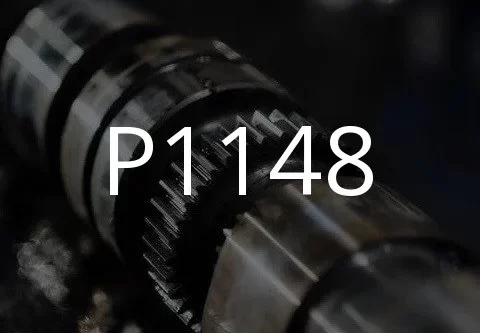
P1148 (Volkswagen, Audi, Skoda, Seat) Heating oxygen sensor (HO2S) control system 1, bank 2 - lambda control, mixture too rich
Content
P1148 – OBD-II Trouble Code Technical Description
Trouble code P1148 indicates a problem in the heating control system of oxygen sensor (HO2S) 1, bank 2 (lambda control), namely, a too rich air-fuel mixture in Volkswagen, Audi, Skoda, Seat vehicles.
What does the fault code mean P1148?
Trouble code P1148 indicates a problem in the heated oxygen sensor (HO2S) 1 control system, located in bank 2 (usually the second bank of cylinders) of the engine. This oxygen sensor measures the oxygen content of exhaust gases, helping the engine controller optimize the fuel/air mixture for best engine efficiency and environmental friendliness. Trouble code P1148 indicates the air/fuel mixture is too rich, meaning there is more fuel in the mixture than optimal.

Possible reasons
Possible reasons for DTC P1148:
- Oxygen sensor (HO2S) malfunction: The oxygen sensor may be damaged or malfunctioning, resulting in an incorrect reading of the oxygen content of the exhaust gases and, as a result, a too rich air-fuel mixture.
- Problems with the fuel injection system: Faulty fuel injectors or fuel pressure problems can cause excess fuel in the cylinders, increasing the fuel content of the mixture.
- Malfunction of the ignition system: Improper operation of the ignition system can cause incomplete combustion of the fuel, which can also lead to a too rich mixture.
- Air filter problems: A clogged or damaged air filter can restrict air flow in the intake system, resulting in too little air and too much fuel in the mixture.
- Incorrect operation of the fuel pressure regulator: If the fuel pressure regulator is not working properly, it can cause excess fuel pressure, which will increase the amount of fuel entering the cylinders.
- Problems with air flow or pressure sensors in the intake system: Faulty or dirty intake system air flow or pressure sensors can send incorrect data to the engine controller, which can cause excess fuel in the mixture.
These are just a few of the possible causes for trouble code P1148. To accurately determine the cause of the problem, it is recommended to diagnose the engine management system using a diagnostic scanner and additional test procedures.
What are the symptoms of a fault code? P1148?
A few common symptoms that may occur when trouble code P1148 appears:
- Loss of power: If the air/fuel mixture is too rich, the engine may experience a reduction in power, especially when accelerating hard or when attempting to increase speed.
- Unstable idle: Incorrect fuel/air ratio can cause the engine to idle rough, resulting in shaking or rattling.
- Increased fuel consumption: Excess fuel in the mixture results in increased mileage or mileage due to inefficient fuel combustion.
- Suspicious exhaust smell: If the mixture is too rich, the exhaust gases may have a more intense fuel odor, which may be noticeable in or around the vehicle.
- Black smoke from the exhaust system: If the mixture is too rich, black smoke may appear in the exhaust gases, especially when accelerating or under heavy engine load.
- Engine errors on the dashboard: Warning messages or indicators appear on the instrument panel indicating problems with the engine management system or exhaust system.
It's important to note that symptoms may vary depending on the specific vehicle, its condition, and other factors. If you suspect a problem with DTC P1148, it is recommended that you contact a qualified auto mechanic for further diagnosis and troubleshooting.
How to diagnose a fault code P1148?
To diagnose DTC P1148, follow these steps:
- Checking the error code: Use a diagnostic scan tool to read error codes from the engine management system. Verify that the P1148 code is indeed present.
- Visual inspection: Inspect the oxygen sensor (HO2S) and its connections for damage, corrosion, or disconnection. Check the condition of the wiring and connectors associated with the sensor.
- Checking the oxygen sensor (HO2S): Use a multimeter to check the resistance and operation of the oxygen sensor. Compare the results with the manufacturer's recommended values.
- Checking the fuel injection system: Diagnose the fuel injection system, including the fuel injectors, fuel pressure, and fuel pressure control system.
- Checking the ignition system: Check the ignition system, including spark plugs, wires and ignition coils, to ensure proper operation.
- Checking the air filter: Check the condition of the air filter for dirt or damage that could restrict air flow in the intake system.
- Fuel pressure check: Measure the fuel pressure in the fuel system to ensure it meets manufacturer specifications.
- Checking air flow and pressure sensors in the intake system: Check the operation of the air flow and pressure sensors in the intake system for malfunctions.
- Checking Other Related Components: Check the engine control system (ECU) and other related components that may affect the air/fuel ratio.
Taking these steps will help you identify the cause of the problem and determine what steps you need to take to resolve the P1148 trouble code. If you are not experienced in diagnosing vehicles, it is recommended that you contact a qualified auto mechanic for assistance.
Diagnostic errors
When diagnosing DTC P1148, the following errors may occur:
- Based on error code only: Based solely on the error code, a mechanic may miss deeper problems that may be related to other components of the engine management system.
- Neglecting additional diagnostic steps: Failure to perform or skip additional diagnostic steps, such as checking other sensors and components, may result in an incorrect diagnosis.
- Not performing a thorough check of the oxygen sensor (HO2S): Failure to pay enough attention to checking the oxygen sensor and its environment may result in the cause of the problem being incorrectly determined.
- Incorrect interpretation of diagnostic data: Incorrect interpretation of data obtained from a diagnostic scanner or multimeter may lead to incorrect conclusions about the status of the system.
- Unaccounted environmental factors: Environmental factors such as ambient temperature and driving conditions can also affect the operation of the oxygen sensor heater control system and cause fault codes to appear.
- Skip checking for air or fuel leaks: Air or fuel leaks in the intake or injection system can cause the oxygen sensor to malfunction, resulting in a P1148 code.
- Incorrect calibration or setup of components: Incorrect calibration or adjustment of the oxygen sensor or other engine management system components may cause incorrect data readings and erroneous diagnostic findings.
To avoid these errors, it is important to perform a comprehensive diagnosis that includes checking all associated components and performing all necessary diagnostic steps.
How serious is the fault code? P1148?
Trouble code P1148 should be taken seriously as it indicates that the air/fuel mixture in the engine is too rich, several reasons why code P1148 should be taken seriously:
- Decreased productivity: An air/fuel mixture that is too rich can cause the engine to lose power, which can affect the overall performance of the vehicle.
- Increased fuel consumption: Excessive fuel in the mixture results in increased fuel consumption per mile or kilometer, which can be an additional financial burden for the owner.
- Harmful emissions: A mixture that is too rich can lead to increased emissions of harmful substances in the exhaust, which has a negative impact on the environment.
- Damage to catalyst: Driving the vehicle for a long time with a mixture that is too rich can damage the catalyst, which will require replacement and additional costs.
- Failed inspection: In some areas, a vehicle with an active code P1148 may not pass inspection due to high emissions.
Although a vehicle with code P1148 may still be drivable, it is recommended that it be diagnosed and repaired as soon as possible to avoid further problems and ensure the engine runs safely and efficiently.
What repair will help eliminate the code? P1148?
Resolving trouble code P1148 depends on the root cause of its occurrence, there are several possible actions that can help in the repair:
- Replacing the oxygen sensor (HO2S): If the oxygen sensor is faulty or broken, it should be replaced. Make sure the new sensor meets the manufacturer's specifications and is compatible with your vehicle.
- Checking and repairing the fuel injection system: Diagnose the fuel injection system, including fuel injectors, fuel pressure and pressure control system. Replace or repair components as necessary.
- Checking the ignition system: Check the ignition system, including spark plugs, wires and ignition coils. Replace or repair components as necessary.
- Checking the air filter: Check the condition of the air filter for dirt or damage that could restrict air flow in the intake system.
- Fuel pressure check: Measure the fuel pressure in the fuel system to ensure it meets manufacturer specifications.
- Checking air flow and pressure sensors in the intake system: Check the operation of the air flow and pressure sensors in the intake system for malfunctions.
- ECU Software Update: If the problem is related to the engine controller (ECU) software, updating the software may help resolve the error.
- Checking for air or fuel leaks: Check the system for air or fuel leaks, which could cause the oxygen sensor to malfunction.
- Calibrating or tuning components: Check that the oxygen sensor and other engine management system components are properly calibrated or configured.
Taking these steps will help identify and eliminate the root cause of the P1148 trouble code. If you are not experienced in diagnosing vehicles, it is recommended that you contact a qualified auto mechanic for assistance.

